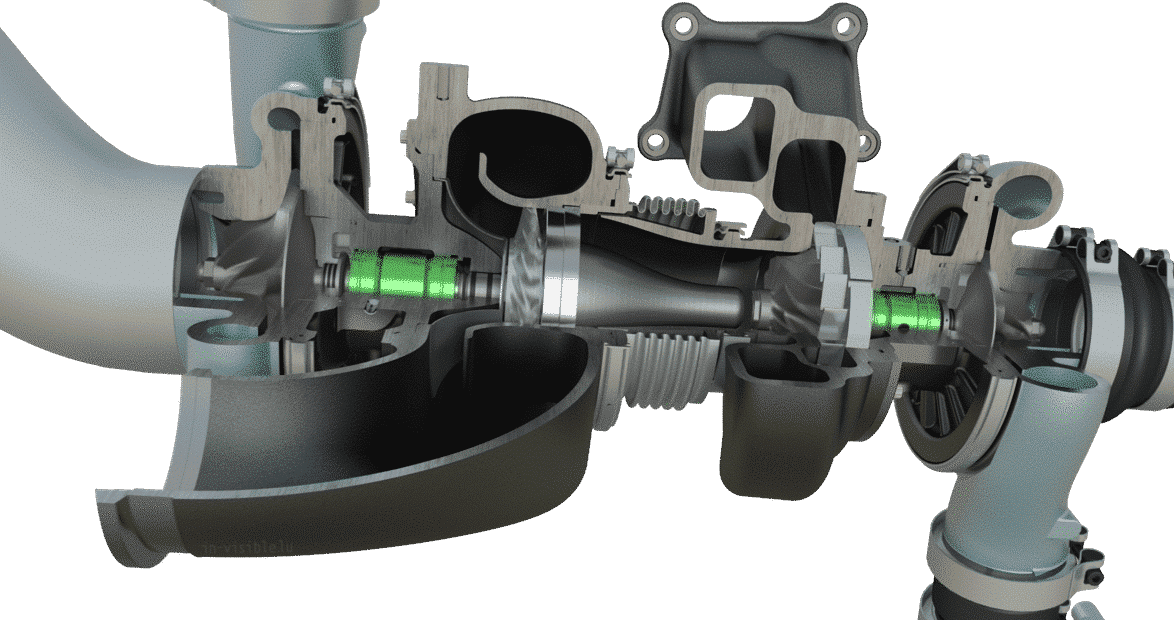More About Turbochargers
Table of ContentsThe Main Principles Of Turbochargers Some Known Details About Turbochargers Turbochargers Things To Know Before You Buy

For example, in Opel bi-turbo Diesel, just the smaller sized turbocharger works at low speed, providing high torque at 1,5001,700 rpm - turbochargers. Both turbochargers run together in mid range, with the smaller sized one pre-compressing the air, which the larger one further compresses. A bypass valve controls the exhaust flow to each turbocharger.
Smaller sized turbochargers have less turbo lag than larger ones, so typically 2 small turbochargers are utilized instead of one big one. This configuration is popular in engines over 2. 5-litres and in V-shape or boxer engines. Twin-scroll or divided turbochargers have 2 exhaust gas inlets and 2 nozzles, a smaller sized sharper angled one for quick action and a larger less angled one for peak efficiency.
In twin-scroll styles, the exhaust manifold physically separates the channels for cylinders that can interfere with each other, so that the pulsating exhaust gasses flow through different spirals (scrolls). With typical shooting order 1342, 2 scrolls of unequal length set cylinders 1 and 4, and 3 and 2. This lets the engine effectively utilize exhaust scavenging techniques, which reduces exhaust gas temperatures and emissions, enhances turbine performance, and lowers turbo lag evident at low engine speeds.
The vanes are put simply in front of the turbine like a set of slightly overlapping walls. Their angle is changed by an actuator to obstruct or increase air circulation to the turbine. This irregularity preserves a similar exhaust speed and back pressure throughout the engine's rev range. The outcome is that the turbocharger improves fuel performance without a noticeable level of turbocharger lag.
The compressor is comprised of an impeller, a diffuser and a volute housing. The operating variety of a compressor is described by the "compressor map". The circulation variety of a turbocharger compressor can be increased by enabling air to bleed from a ring of holes or a circular groove around the compressor at a point a little downstream of the compressor inlet (however far nearer to the inlet than to the outlet).
Indicators on Turbochargers You Should Know
It accomplishes this by forcing a simulation of impeller stall to take place continuously. Permitting some air to leave at this place hinders the start of surge and expands the operating range. While peak performances might decrease, high effectiveness might be accomplished over a higher variety of engine speeds. Increases in compressor effectiveness result in a little cooler (more thick) consumption air, which enhances power.
The capability of the compressor to offer high increase at low rpm might also be increased marginally (because near choke conditions the compressor draws air inward through the bleed path). Ported shrouds are used by numerous turbocharger makers. The centre hub rotating assembly (CHRA) houses the shaft that connects the compressor impeller and turbine.

Ball bearings created to support high speeds and temperatures are often utilized instead of fluid bearings to support the turbine shaft. This assists the go to my blog turbocharger speed up faster and lowers turbo lag. Some variable nozzle turbochargers utilize a rotary electric actuator, which utilizes a direct stepper motor to open and close the vanes, rather than pneumatic controllers that run based on atmospheric pressure.
When the pressure of the engine's intake air is increased, its temperature level likewise increases. This occurrence can be explained through Gay-Lussac's law, stating that the pressure of a given quantity of gas held at continuous volume is straight proportional to the Kelvin temperature. With more pressure being contributed to the engine through the turbocharger, general temperatures of the engine will also rise.
The warmer the intake air, the less thick, and the less oxygen readily available for the combustion occasion, which decreases volumetric effectiveness. Not just does excessive intake-air temperature reduce efficiency, it also causes engine knock, or detonation, which is destructive to engines. To make up for the boost in temperature level, turbocharger units frequently make usage of an intercooler between succeeding stages of increase to cool off the consumption air.
Get This Report about Turbochargers
There are two locations on which intercoolers are frequently installed. turbochargers. It can be either mounted on top, parallel to the engine, or mounted check it out near the lower front of the automobile. Top-mount intercoolers setups will lead to a decrease in turbo lag, due in part by the location of the intercooler being much closer to the turbocharger outlet and throttle body.
Front-mount intercoolers can have the potential to provide better cooling compared to that of a top-mount. The location in which a top-mounted intercooler is located, is near one of the most popular locations of a car, right above the engine. This is why most manufacturers consist of large hood scoops to help feed air to the try these out intercooler while the automobile is moving, but while idle, the hood scoop offers little to no advantage.
With more distance to take a trip, the air distributed through a front-mount intercooler may have more time to cool. Methanol/water injection has been around considering that the 1920s however was not used till World War II. Adding the mixture to intake of the turbocharged engines decreased operating temperatures and increased horse power.